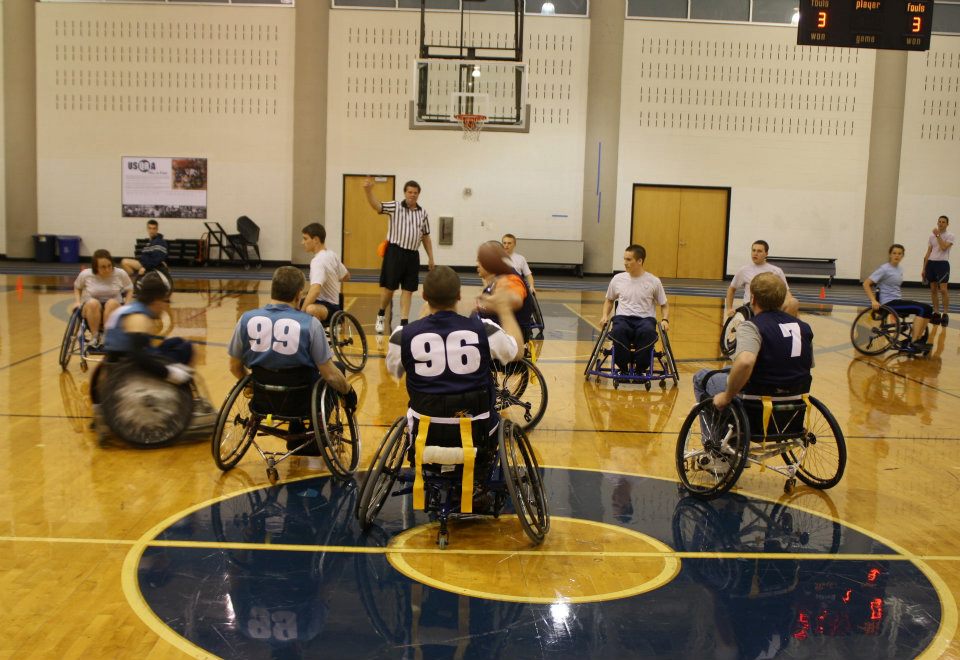Introduction
American wheelchair football is an adaptation of American football played by individuals in either manual or motorized wheelchairs. These individuals can have any variety and/or or combination of disability conditions or have no disabilities whatsoever. This potential for such a broad range of players and ability levels makes American wheelchair football one of, if not the most, inclusive of all current sports.
The game has gained tremendous popularity since its creation in the 1990s. It can be played in any number of formats with varying numbers of participants and types of courts/fields, rules and equipment used. This is one of the greatest strengths of the game, as it can be adapted to accommodate any number and variety of players.
Benefits of Playing the Sport
The game offers many potential benefits to all its players with and without disabilities. Players using manual wheelchairs must engage in many quick and powerful movements, such as cutting, blocking, sprinting and tackling, that require and may help build cardiovascular and muscular strength. Participants who have difficulty or are unable to push and use designated pushers (individuals who push and maneuver their chairs) who may miss out on some of these physical benefits can still reap the many social and mental benefits associated with being included as part of a team in a competitive environment.

Classification and Rules
One of the best, strongest facets of American wheelchair football is that there are so many different classifications and adaptations that can be made to make each game as unique as possible. All aspects of the game, such as rules of play and eligibility, scoring, equipment and even the field of play can be altered for each match.
The only mandatory requirement for a game of wheelchair football is that all players must be in a wheelchair. Some leagues will include provisions so individuals who cannot operate a manual or motorized wheelchair can enlist the aid of a designated pusher whose sole job is to propel and maneuver the individual in the chair. A pusher is not a player and cannot influence the action beyond maneuvering the player.
Examples of other adaptations may include the following:
- Field or court of play- Games must be played on a flat, rectangular surface. Many leagues utilize a standard-sized basketball court, using lines around the perimeter of the court and beneath the basket to represent boundaries and goal lines, respectively. Additionally, the basket may be incorporated as a modified field goal post and/or target.
- Players- Games can vary tremendously in number of players, based on such factors as number of players in attendance and court size. Some leagues have rules to accommodate for teams that range from five to 14 players.
- Chair usage- Typically, it is required that players remain in their chairs throughout a play, or else they will be disqualified and possibly penalized for the play.
- Penalties- Referees may call penalties for a variety of reasons established by a league. These may include holding and other improper contact, leaving a wheelchair, interfering with a pass, illegal blocking and other actions that may affect a game.
- Scoring- Typically, a touchdown counts as six points, and a field goal counts as three points. A field goal may vary from throwing a ball between the uprights on top of a basketball goal to hitting the back board of a basketball goal, to name two options. A point-after-touchdown may always count as one or two points or may vary based on how it is scored (ex: one point for rushing it in, two points for throwing it in).
- Receiving- Some leagues may require a ball to be physically caught. Others may allow, based on the physical ability level of a receiver (ex: an individual with tetraplegia or limb loss), that a ball that hits the receiver in a designated area (chest, back, arm, leg, chair, etc.) counts as a catch, while receivers with more complete use of their hands still have to physically catch a pass.
- Tackling- Tackling rules may be very broad as well. A league may require that a two-hand touch be made to count as a tackle but modify that rule so that individuals with limb loss or function loss can tackle with one hand. Some leagues use breakaway or Velcro flag belts, like those used in flag football, attached around the wheelchair that must be removed to count as a tackle.
- Kicking- Kickoffs, punts and field goals are replaced with throws as opposed to kicks.
Equipment
There are not many pieces of equipment involved in an American wheelchair football game. The only necessary items are a field, wheelchairs and a ball. As mentioned, the field should include boundary and goal line markers, as well as a goal post/target for field goals. Any type of chair can be used, from a standard daily use chair to a sports chair to a motorized chair. Finally, the type of ball can vary greatly, from a softer, Nerf-type ball to a more traditional leather ball of any size. Additionally, if an individual with vision impairment or blindness is playing, a noise-emitting ball may be used to help them know where it is throughout the game.
American wheelchair football is billed by some as the ultimate inclusive sport due to the vast number of accommodations that can be used to make the game truly inclusive of all people, regardless of ability level. Contact your nearby adaptive rec facility to see if football is being offered in your area.
